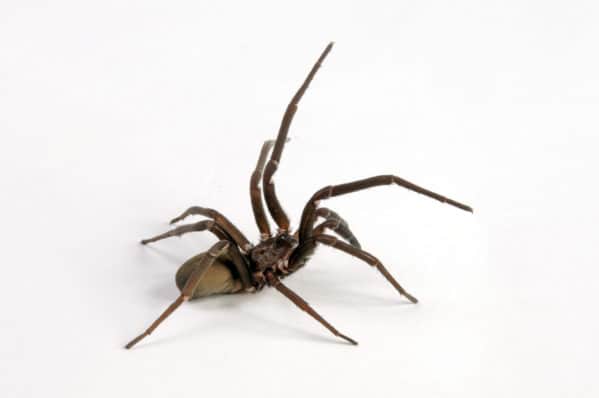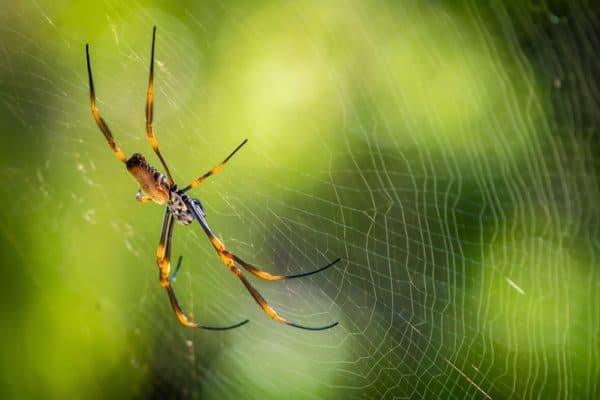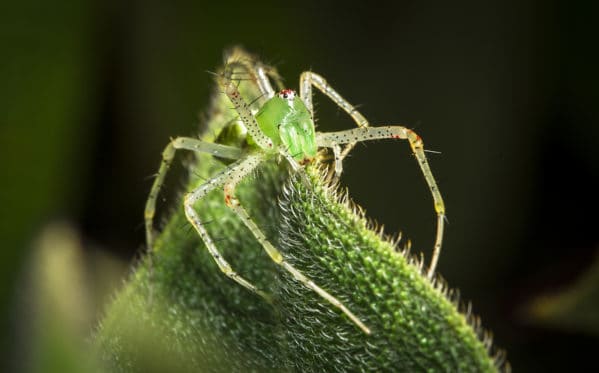READY TO GET STARTED?
REQUEST A FREE ESTIMATE
Fill out the form below or call (888) 466-7849 for a free, no-obligation estimate.

The climate of Georgia (and the southern United States in general) provide the ideal environment for several species of spiders. The humidity and subtropical conditions provide just the right setting for these pests to thrive. Almost all species of spiders found in the United States pose no threat to humans. In fact, of the 38 known species of spiders in Georgia, only 2 are harmful to humans. Here are 10 of the most common spiders found in Georgia and the threat they may pose to you and your family.

Black widow spiders are black and shiny in color with a prominent red hourglass shape on their back. They are most often found around woodpiles and can easily access your home by hitching a ride inside on your firewood. They are also found in common places around your home where they can be undisturbed like eaves, empty boxes, and even shoes that are stored away and never worn. Black widows can be harmful to humans if bitten. While males rarely bite, females have been known to be aggressive especially when they are guarding their eggs. Black widow bite symptoms include fever, elevated blood pressure, nausea, and sweats. Death is uncommon after a black widow bite, especially if treatment is received quickly. In fact, there has not been a black widow related death in the United States in over 10 years.

Brown recluse spiders are light to dark brown in color (hence their name) with a signature dark brown violin shape on their backs. They are commonly found outdoors in debris and woodpiles. If they are found indoors, they are usually found underneath furniture, inside storage bins, and in dark recesses like baseboards. They are often found hiding out in closets, attics, and crawlspaces. Brown recluse spiders will bite when on the defensive. These bites are very painful and often leave an open, ulcerating sore that must be treated by a medical professional. Other symptoms include fever, restlessness, and difficulty sleeping.

House spiders vary in color but most are yellow to brown in color with elongated abdomens. They are most often found inside homes (hence their name) usually in ceiling corners, under furniture, and inside closets, basements, garages, and crawlspaces. When outdoors, they are often found around windows, under eaves, and near light sources. While they can be a nuisance to have in your home, they don’t pose any threat to humans. Because of the low humidity and fewer insects in modern homes, house spiders are becoming less common in houses and more likely to be found in garages, sheds, barns, and warehouses.

Wolf spiders are typically dark brown in color with pale markings or stripes. Their legs are long and spiny and most have hair on their bodies. When indoors, wolf spiders typically stay on or near the floor, especially along walls and under furniture. They often come inside on firewood. When found outside they are usually found under firewood piles, leaves, yard debris, and stones and will often hide in these places during the day. While wolf spiders can bite, these incidents are rare and they don’t pose a significant threat to humans. Wolf spiders are unique in that they don’t capture their prey in webs but rather by chasing them down using their speed.

Crevice spiders have similar shapes and coloring as brown recluse spiders and are, in fact, often mistaken for them. While they do have the same light to dark brown coloring and similar body shape, they do not have the signature violin-shaped markings that the brown recluse has. They are often found in corners and crevices which is where their name comes from, typically located in ceiling corners, along baseboards, and in window frames. They can be beneficial to homeowners as they eat common household pests like flies, roaches, beetles, and wasps. While they can bite if threatened, this is very rare and they do not pose a significant threat to humans.

The yellow garden spider is a large, black and yellow spider that is known for spinning large circular webs. Females are black with bright yellow patches on their abdomens. Males are smaller with less yellow coloring on their abdomens. They are typically found outdoors in sunny areas with plants on which they can anchor their webs (hence their name). Garden spiders don’t pose a threat to humans (other than the chance of walking through their sometimes significantly large webs) but they do produce venom that is harmless to humans, but helps to immobilize prey like flies, bees, and other flying insects that are caught in the web.

Orb weaver spiders can vary in size and coloring but are often mistaken for brown recluse spiders. They are known for creating distinctive sheet webs with an escape tunnel at the rear. These webs can be up to 3 feet in diameter. Many orb weavers are brightly colored, have hairy or spiny legs and a relatively large abdomen. Orb weavers are typically nocturnal spiders and many species will build or do repair work on their webs at night. Orb weavers do not pose a threat to humans. They will bite if cornered but the bite is comparable to a bee sting.

The lynx spider is bright green in color, resembling the color of a plant leaf. They will also sometimes have orange on their legs and black dots, as well. Their legs are covered in long black spines. They are very quick in movement and are able to jump large distances to capture their prey. They are often found in open fields, especially those with tall grass surroundings. The lynx spider can be quite useful in agricultural management. They will bite if on the defensive but they do not pose a significant threat to humans.

The trapdoor spider is a large, hairy spider that can range in color from yellowish brown to reddish brown to black. They have powerful jaws and sharp fangs. Trapdoor spiders get their name from the burrows they construct with a cork-like trapdoor made of soil, vegetation and silk. They spend most of their lives underground and usually hunt at night. Trapdoor spiders are not aggressive and, in fact, are often timid when confronted. They can bite but this is rare. They do not pose a significant threat to humans.

The hobo spider is light to medium brown in color with a down the center with an oblong abdomen. Hobo spiders build funnel webs that open at both ends with one end expanding outward into a broad, slightly curved sheet. Mating season is from June to October and the wandering of males in search of a mate brings them in to much more contact with humans than females. Therefore, male hobo spiders are responsible for more bites than females because of this increased contact with humans. Their bites, however, do not pose a significant threat to humans. Hobo spiders can be found in almost any habitat. They are commonly found in places with holes, cracks, or crevices. They are terrible climbers and are rarely found above ground level. They prefer dark, moist environments like basements, crawlspaces, and window wells.

Contrary to popular belief, Granddaddy Longlegs are not, in fact, spiders; they actually belong to a group of arachnids known as harvesters or harvestmen. The predominant feature of harvesters including the granddaddy longlegs is legs that are exceptionally long in relation to their body size. Harvesters are usually seen around harvest time – hence their name. Just in North America alone there are about 150 species of granddaddy longlegs. They use their extremely long legs to catch their prey rather than building webs. Granddaddy longlegs are not poisonous or venomous and do not pose any threat to humans.
Whether they are dangerous to humans or not, most people would prefer to keep spiders out of their homes as much as possible. The best way to prevent spiders from taking up residence in your house is to get rid of any areas where they can hide. Spiders are more common in the fall and winter as they make their way indoors in search of food and warmth. Keep your garage, attic, and basement clear and decluttered. Try not to leave shoes and clothing on the floor. Seal any cracks and crevices around your home. Consider enclosing your crawlspace and sweep down any cobwebs that appear. As always, if you suspect you have a spider problem, contact a professional pest control company who can help identify the type of spiders you have and provide you with a thorough evaluation and treatment and prevention plan.
How Much Damage Can Termites Really Cause?
Categories